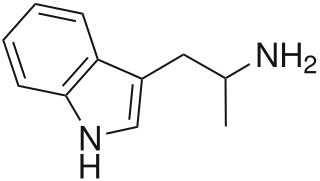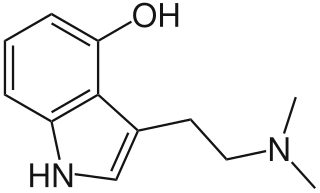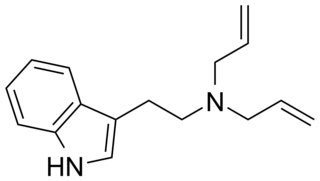
α-Methyltryptamine is a psychedelic, stimulant, and entactogen drug of the tryptamine class. It was originally developed as an antidepressant by workers at Upjohn in the 1960s, and was used briefly as an antidepressant in Russia under the trade name Indopan before being discontinued.

Psilocin is a substituted tryptamine alkaloid and a serotonergic psychedelic substance. It is present in most psychedelic mushrooms together with its phosphorylated counterpart psilocybin. Psilocin is a Schedule I drug under the Convention on Psychotropic Substances. Acting on the 5-HT2A receptors, psilocin modulates the production and reuptake of serotonin. The mind-altering effects of psilocin are highly variable and subjective and resemble those of LSD and DMT.

5-MeO-DALT or N,N-di allyl-5-methoxy tryptamine is a psychedelic tryptamine first synthesized by Alexander Shulgin.

4-HO-MiPT is a synthetic substituted aromatic compound and a lesser-known psychedelic tryptamine. It is thought to be a serotonergic psychedelic, similar to magic mushrooms, LSD and mescaline. Its molecular structure and pharmacological effects somewhat resemble those of the tryptamine psilocin, which is the primary psychoactive chemical in magic mushrooms.

N-Methyl-N-isopropyltryptamine (MiPT) is a psychedelic tryptamine, closely related to DMT, DiPT and Miprocin.

5-MeO-DPT, is a psychedelic and entheogenic designer drug.

4-HO-DPT is a substituted tryptamine with psychedelic effects. It is the 4-hydroxyl analog of dipropyltryptamine (DPT).

4-Hydroxy-N-methyl-N-propyltryptamine, commonly known as 4-HO-MPT or meprocin, is a psychedelic drug in the tryptamine class of chemical compounds and is a higher homologue of the naturally occurring substituted tryptamine psilocin as well as being the 4-hydroxyl analog of MPT.

Aeruginascin or N,N,N-trimethyl-4-phosphoryloxytryptamine is an indoleamine derivative which occurs naturally within the mushrooms Inocybe aeruginascens and Pholiotina cyanopus, and Psilocybe cubensis. Aeruginascin is the N-trimethyl analogue of psilocybin. It is closely related to the frog skin toxin bufotenidine (5-HTQ), a potent 5-HT3 receptor agonist, but the aeruginascin metabolite 4-HO-TMT shows strong binding at the 5-HT2 receptors similar to psilocin. The first scientific literature about the pharmacological effects of aeruginascin is from a study published by Gartz in 1989. Across 23 analyzed cases of accidental hallucinogenic mushroom poisonings, people who had ingested the mushroom Inocybe aeruginascens reported only euphoric experiences. This is in contrast to the slight and in some cases extremely dysphoric experiences reported from the accidental ingestion of non aeruginascin containing mushrooms (containing solely psilocybin and psilocin).

MS-245 is a tryptamine derivative used in scientific research. It acts as a selective 5-HT6 receptor antagonist with a Ki of 2.3 nM, and was derived through structure-activity relationship development of the selective 5-HT6 agonist EMDT. It has been used as a lead compound for further development of tryptamine-derived 5-HT6 antagonists. In animal studies it has been shown to boost the activity of, but not substitute for, both amphetamine and nicotine.

N,N-Diallyltryptamine (DALT) is a tryptamine derivative which has been identified as a new psychoactive substance. It has been used as an intermediate in the preparation of radiolabeled diethyltryptamine.

5-Ethoxy-DMT is a tryptamine derivative which has been previously synthesized as a chemical intermediate, but has not been studied to determine its pharmacology.

Substituted tryptamines, or serotonin analogues, are organic compounds which may be thought of as being derived from tryptamine itself. The molecular structures of all tryptamines contain an indole ring, joined to an amino (NH2) group via an ethyl (−CH2–CH2−) sidechain. In substituted tryptamines, the indole ring, sidechain, and/or amino group are modified by substituting another group for one of the hydrogen (H) atoms.

5-HO-DiPT (5-hydroxy-N,N-di-iso-propyltryptamine) is a tryptamine derivative which acts as a serotonin receptor agonist. It is primarily known as a metabolite of the better known psychoactive drug 5-MeO-DiPT, but 5-HO-DiPT has also rarely been encountered as a designer drug in its own right. Tests in vitro show 5-HO-DiPT to have high 5-HT2A affinity and good selectivity over 5-HT1A, while being more lipophilic than the related drug bufotenine (5-HO-DMT), which produces mainly peripheral effects.

4-HO-McPT (4-hydroxy-N-methyl-N-cyclopropyltryptamine) is a psychedelic tryptamine derivative. It has serotonergic effects, and has reportedly been sold as a designer drug since around 2016, but was not definitively identified by forensic laboratories until 2018. It is illegal in Finland.

4-Propionoxy-N,N-dimethyltryptamine is a synthetic psychedelic drug from the tryptamine family with psychedelic effects, and is believed to act as a prodrug for psilocin. It produces a head-twitch response in mice. It has been sold online as a designer drug since May 2019. It was first identified as a new psychoactive substance in Sweden, in July 2019.

5-MeO-MET (5-Methoxy-N-methyl-N-ethyltryptamine) is a relatively rare designer drug from the substituted tryptamine family, related to compounds such as N-methyl-N-ethyltryptamine and 5-MeO-DMT. It was first synthesised in the 1960s and was studied to a limited extent, but was first identified on the illicit market in June 2012 in Sweden. It was made illegal in Norway in 2013, and is controlled under analogue provisions in numerous other jurisdictions.

5-MeO-DBT is a rare substituted tryptamine derivative, which is thought to be a psychoactive substance and was identified in a designer drug sample by a forensic laboratory in Slovenia in March 2021, although only analytical studies have been conducted and no pharmacological data is available. It is nevertheless controlled under drug analogue legislation in a number of jurisdictions.

MALT is a lesser-known drug from the tryptamine family. It is a novel compound with very little history of human use. It is closely related to methylpropyltryptamine (MPT), as well as N-methyltryptamine. It has been sold online as a designer drug. Very little information on the pharmacology or toxicity of MALT is available.

4-HO-MALT (4-hydroxy-N-methyl-N-allyltryptamine) is a tryptamine derivative which has been sold as a designer drug, first being detected in Slovenia in 2021.




















